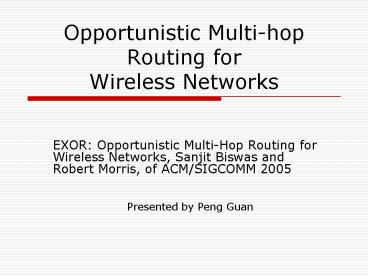Opportunistic Multihop Routing for Wireless Networks PowerPoint PPT Presentation
Title: Opportunistic Multihop Routing for Wireless Networks
1
Opportunistic Multi-hop Routing for Wireless
Networks
- EXOR Opportunistic Multi-Hop Routing for
Wireless Networks, Sanjit Biswas and Robert
Morris, of ACM/SIGCOMM 2005 - Presented by Peng Guan
2
Outline
- Background
- Basic idea
- Protocol design details
- Measurements
- Conclusion
3
Background
- Wireless networks
Wireless mesh network
Wireless ad hoc network
4
Traditional routing
packet
packet
packet
A
B
src
dst
packet
packet
C
- Identify a route, packets forward over fixed path
- Retried on failures
5
Wireless different from wire
A
B
No such thing as a LINK
src
dst
1
2
3
4
5
6
1
2
3
6
3
5
4
2
3
4
5
6
1
2
4
5
6
1
C
- Packet is broadcast
- Reception is probabilistic
6
Outline
- Background
- Basic idea
- Protocol design details
- Measurements
- Conclusion
7
Basic idea
A
B
src
dst
packet
packet
packet
packet
packet
C
packet
packet
packet
packet
- Figure out which nodes rxd broadcast
- Node closest to destination forwards
8
Basic idea (2)
1
1
2
2
1
s
3
batch
d
1
2
1
2
2
1
4
5
1
- The source broadcasts a batch to a sub-set of
nodes - The node closest to the destination forwards
(broadcast) fragment
9
ExOR might providemore throughput
- Assumes independent losses
- Traditional routing 1/0.25 1 5 tx
- ExOR 1/(1-(1-0.25)4) 1 2.5 tx
10
ExOR might providemore throughput (contd)
- Probability falls off gradually with distance
- Traditional route through N2, N4
- Take advantage of transmissions that reach
unexpectedly far, or fall unexpectedly short - Node closest to the dst has highest priority
11
Assumptions and Goals
- Assumptions
- Many receivers hear every broadcast
- Gradual distance-vs-reception tradeoff
- Receiver losses are uncorrelated
- Goals
- Exploiting probabilistic broadcast
- High throughput and network capacity
12
Outline
- Background
- Basic idea
- Protocol design details
- Measurements
- Conclusion
13
ExOR Packet header format
14
Protocol Design
- Sources behavior
- Intermediate nodes behavior
- Destination behavior
15
Sources behavior
- Collects enough packets of the same destination
to form a batch - ExOR operates on batches of packets for
efficiency - Selects a set of nodes to be candidate
forwarders, and includes the prioritized list in
the header of every packet
16
Priority ordering
- Goal nodes closest to the destination send
first - Higher delivery probability, closer to the
destination
17
Priority ordering (2)
- ETX1/(delivery prob)
- Sort by ETX metric to dst
Forwadlist ECDBA Broadcast in this order
18
Protocol Design
- Sources behavior
- Intermediate nodes behavior
- Destination behavior
19
Forwarders behavior
- Q How can a node know whether it is one of the
forwarders or not? - A Check the forwarder list in the overhead of
the received packet - If the node finds itself in the list, buffer the
packet and keep state of this batch - If no, discard the packet
20
Forwarders behavior (2)
- Q How can a node know whether the packet it
receives has also been received by a node with
higher priority or not? - A ExOR designs a batch map to record, for
every packet in the batch, the highest-priority
node known to have received that packet.
21
Forwarders behavior (3)
- Q How can a node know which packet it should
transmit? - A ExOR add a fragment size and fragment
number in the overhead of every packet. - Fragment size number of packets the node has to
send - Fragment no. the index of the sending packet in
the fragment
22
Forwarders behavior (4)
B 11SSS
1
2
1
D
S
3
1
4
2
B SSDSS
2
1
2
3
4
5
B SSSSS
B 2SD2S
1
3
4
2
B 2S22S
B 2SD2S
Sending Packets 1,2,3,4,5 Forwarder List
D,2,1,S
23
Protocol Design
- Sources behavior
- Intermediate nodes behavior
- Destination behavior
24
Destinations behavior
- Actually destination is the last intermediate
node and has the highest priority. - After the finish of srcs transmission.
Destination sends out ten packets only including
the batch map, to inform other nodes about the
packets it has received
25
Outline
- Background
- Basic idea
- Protocol design details
- Measurements
- Conclusion
26
65 Roofnet node pairs
27
ExOR 2x overall improvement
- Median throughputs
- 1. 240Kbit/s for ExOR
- 2. 121Kbit/s for Traditl
28
25 highest throughput pairs
29
25 lowest throughput pairs
30
Conclusion
- ExOR achieves 2x throughput improvement
- Future work will focus on
- Choosing best 802.11 bit rate
- Cooperation between simultaneous flows
31
THANKS
- QA?

